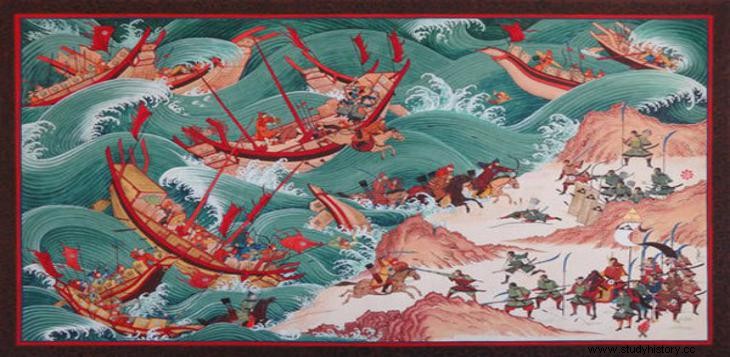If today we talk about a kamikaze, we all think that we are referring to the suicide pilots of the Japanese Imperial Navy who launched themselves against allied units or installations during World War II, but the legend of the Kamikaze (divine wind ) refers to two powerful typhoons that destroyed Kublai Khan's Mongol fleet when he attempted to conquer Japan twice during the 13th century. Clarified, let's go with the terrible story of a kamikaze family.

Kamikaze (Divine Wind)
In mid-1944, after several strategic defeats, including the loss of the Saipan base from which the Americans could launch their B-29 bombers, things began to get very difficult for the Japanese on the Pacific Front. If we add to this that the Allied air superiority was already too evident, that the gap in industrial capacity to produce new ships was widening in favor of the Americans, as well as that of recruiting new pilots, and we do not forget the unwillingness to give up, we have a scenario ripe for despair, leading to nothing mattering anymore and the idea that sacrifice represents the only solution. And that only solution was to create a special attack unit (Tokkotai ), formed by volunteers to convert their planes into pilot-guided torpedoes. They were the first organized kamikazes, isolated suicide attacks since the attack on Pearl Harbor in 1941. The first kamikazes enjoyed the element of surprise and had some success, but once the Americans understood what they were dealing with they became easy prey. Nearly 4,000 pilots died on these suicide missions, most between the ages of 18 and 24. They believed that dying for Japan and its emperor was very honorable, they felt they were the heirs of the samurai of the Middle Ages.

Although there was also a lot of manipulation and fear of being branded as cowards, the stories of the kamikazes are halfway between fanaticism and honor, but none reaches the extreme of that of the Japanese pilot Hajime Fujii and his wife Fukuko .

Hajime Fujii
Hajime was injured in the hand during the war between Japan and China in the 1930s. He was taken to the hospital and there he was treated by Fukuro, the nurse who would become his wife and with whom he would have two girls:Kazuko and Chieko. Due to disability caused by injuries to his left hand, he was sent to the Imperial Japanese Army Air Force Academy where, upon graduation, he was appointed an instructor. Hajime took it upon himself to train future pilots and, later, kamikazes, instilling in them a deep sense of loyalty and patriotism. To Hajime he was not posturing, he believed in those ideals and often told them that he would die with them if he could. And that precisely made him feel like a hypocrite. So even though his wife asked him not to, he offered his superior to be part of the next suicide squad. On two occasions his application was rejected because he was married and had children. The kamikazes had to be single.
Logically, Fukuko was happy about it…at first. As the days went by, she saw how the frustration and torment turned her husband into a lost soul, and even she came to feel responsible for that situation. So, she tackled the problem by making a terrible decision. On the morning of December 14, 1944, while her husband was at the academy, Fukuko wrote a letter to her husband asking him to do her duty and not worry about her family, they would wait for him. He dressed in her best kimono and left the house with Kazuko (3 years old) and Chieko (1 year old). She tied herself together with her daughters and threw herself into the icy waters of the Arakawa River.

Fukuko, Kazuko and Chieko
Now he was the one who felt guilty, he only had to do what his wife asked him to do. He buried his family and wrote a letter to his eldest daughter...
It is painfully sad that together with your mother and sister you sacrificed for your father because of my fervent desire to give my life for our country. […] Dad will be with you very soon. At that time I will hold you while you sleep. If Chieko cries, take good care of her. […] Dad will perform a great deed on the battlefield and bring it to you as a gift.

Letter from Hajime Fuji to his daughter
Hajime cut off his little finger and resubmitted his application signed in his own blood which, logically, was accepted. Just before dawn on May 28, 1945, the nine planes of the Shinbu Squadron, commanded by Hajime, headed for Okinawa, when they ran into two destroyers, the USS Drexler and the USS Lowry . Hajime gave the order and they charged at them. Seven aircraft were shot down before reaching their targets and only two managed to hit the Drexler , sinking it in a matter of minutes. Hajime piloted one of them. The next day, Fukuko's father received a telegram that Hajime had written shortly before taking off for Okinawa.
I look forward to meeting with Fukuko, Kazuko and Chieko.
I knew it would be that day.
